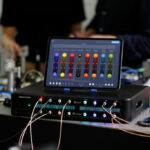Remember when the biggest worry about leaving your kids home alone was whether they’d remember to lock the door? Those days feel like ancient history now. Today’s parents face a completely different challenge – managing a household that’s becoming smarter by the day while ensuring their children’s safety in an increasingly connected world.
The problem isn’t just about safety anymore. It’s about creating smart home solutions that work for the whole family, especially when 73% of parents admit they feel overwhelmed by the number of connected devices in their homes. How do you balance cutting-edge technology with child-friendly design? How do you create products that make parents’ lives easier without making kids feel like they’re living in a high-tech prison?
This is the story of how one smart home brand decided to solve this puzzle – not by guessing what families wanted, but by asking them directly.
The Smart Home Revolution Isn’t Slowing Down
Smart home technology isn’t just a luxury anymore – it’s becoming a necessity for modern families. The numbers tell a compelling story about where this industry is heading.
The smart home market is experiencing explosive growth, with global spending expected to reach $183.5 billion by 2025. But here’s what makes this growth particularly interesting: 68% of smart home device purchases are driven by safety and security concerns, not just convenience. Parents aren’t buying these products to show off – they’re investing in peace of mind.
Major technology companies are taking notice and pouring resources into smart home innovation. Amazon has invested over $1 billion in Alexa and smart home partnerships over the past three years. Google’s parent company Alphabet allocated $2.3 billion to smart home acquisitions and development in 2023 alone. Apple’s HomeKit ecosystem now supports over 1,000 different smart home products, representing a 340% increase from just five years ago.
But perhaps the most telling statistic is this: 82% of parents say they would pay more for smart home products specifically designed with children in mind.
The challenge for smart home brands has become clear: how do you create products that satisfy tech-savvy parents while remaining safe, intuitive, and engaging for children of all ages?
When Innovation Meets Reality: A Brand’s Dilemma
A mid-sized smart home company has been developing traditional security products for years. They were successful in the adult market but noticed a growing gap – parents were asking for smart home solutions that could work seamlessly with children in the house.
The company’s product development team faced a classic innovation challenge. They could create sophisticated products based on market research and technical specifications, but would these products actually solve real family problems? More importantly, would they be safe and user-friendly for children?
Instead of relying solely on internal brainstorming and focus groups, they decided to co-innovate with their target audience – parents from around the world who were already living with smart home technology.
The Global Conversation Begins
The tech company partnered with The Panel Station to conduct a comprehensive survey across 40 countries, reaching parents who were actively using or considering smart home products. The goal wasn’t just to gather opinions – it was to understand the real-life scenarios, frustrations, and wishes that could guide product development.
The survey reached 30,000 parents across diverse markets including the United States, United Kingdom, India, Australia, Germany, Brazil, Japan, and 33 other countries. This global approach was crucial because smart home adoption and family dynamics vary significantly across cultures and regions.
The survey covered everything from daily routines and safety concerns to technology comfort levels and budget considerations. But the most valuable insights came from open-ended questions that let parents share their specific situations and creative ideas.
What Parents Really Want: Ideas from Around the World
The responses revealed fascinating patterns and surprisingly creative solutions. Here are some of the most compelling co-creating ideas that emerged from parents across the globe:
Emotion-Sensing Night Lights – Many parents proposed night lights that could detect when children were upset or scared, automatically adjusting brightness and color to provide comfort while alerting parents through their smartphones.
Kitchen Safety Zones – Parents in the United States and Canada wanted smart kitchen systems that could create “no-go zones” for children around dangerous appliances while still allowing supervised cooking activities.
Homework Helper Hubs – Many Indian and Southeast Asian families suggested smart home controls that could automatically adjust lighting, temperature, and eliminate distractions during designated homework hours.
Emergency Communication Pods – Many parents also proposed child-friendly panic buttons that could instantly connect kids to parents, grandparents, or emergency services with location tracking.
The Winning Idea: Safety Meets Simplicity
When Tech company analyzed all the responses, one concept emerged as the clear winner. 67% of surveyed parents said their most needed smart home product would be a “Family Communication Hub” – a central device that could manage safety, communication, and daily coordination without being overwhelming or intrusive.
The concept combined several elements that parents consistently mentioned:
- Simple Communication: Children could easily contact parents or approved family members with one-touch buttons
- Location Awareness: Parents could know when kids arrived home safely without constant check-ins
- Activity Monitoring: Basic oversight of daily routines without invasive surveillance
- Emergency Features: Quick access to help in genuine emergencies
- Educational Integration: Fun ways to learn while staying safe
Interestingly, 43% of parents also emphasized that any smart home product for families needed to have clear privacy protections and give children age-appropriate control over their own space. This insight proved crucial in the final product design.
From Feedback to Innovation: The Co-Creation Process
The Tech company didn’t just collect these ideas and disappear into their development labs. They maintained ongoing communication with survey participants, sharing prototype concepts and gathering feedback throughout the design process.
The co-creating approach revealed several crucial insights that traditional product development might have missed:
Cultural Sensitivity Matters: What felt safe and appropriate in one country didn’t necessarily translate to another. The final product needed customizable settings to respect different family values and parenting styles.
Children Are Stakeholders Too: Parents consistently mentioned that products failed when children felt excluded from the design process. The successful smart home solution needed to make kids feel empowered, not monitored.
Simplicity Trumps Features: While parents appreciated sophisticated capabilities, they consistently chose simpler, more reliable solutions over feature-rich products that were difficult to use daily.
Integration Is Key: Families didn’t want another standalone device – they wanted smart home products that worked seamlessly with their existing technology ecosystem.
The Result: Innovation Driven by Real Families
Months after that initial survey, the Tech company launched a smart home communication and safety device that directly incorporated ideas and feedback from thousands of parents worldwide.
The product features child-friendly emergency communication, customizable family messaging, location-aware notifications, and educational mini-games that teach digital safety. But perhaps most importantly, it includes privacy controls that let families adjust monitoring levels as children grow and mature.

Recent industry data shows that companies practicing co-creating with customers see 23% higher customer satisfaction scores and 18% better product adoption rates compared to traditional development approaches. More importantly, products developed through consumer collaboration have 31% lower return rates and generate 27% more positive reviews.
Beyond Products: Building Relationships
What makes co-creating in smart home technology so powerful isn’t just the better products it creates – it’s the relationships it builds between brands and consumers. When companies genuinely listen to customer ideas and implement meaningful changes based on feedback, they create a sense of partnership that goes far beyond typical buyer-seller dynamics.
This collaborative relationship also creates more realistic expectations. When customers understand the development process and constraints companies face, they become more patient with limitations and more appreciative of improvements.
The conversation is just getting started. What ideas will you contribute?
Want to share your thoughts on smart home innovation? Join thousands of consumers helping shape the future of technology through The Panel Station’s research community. Your experiences could inspire the next breakthrough in smart home solutions.









